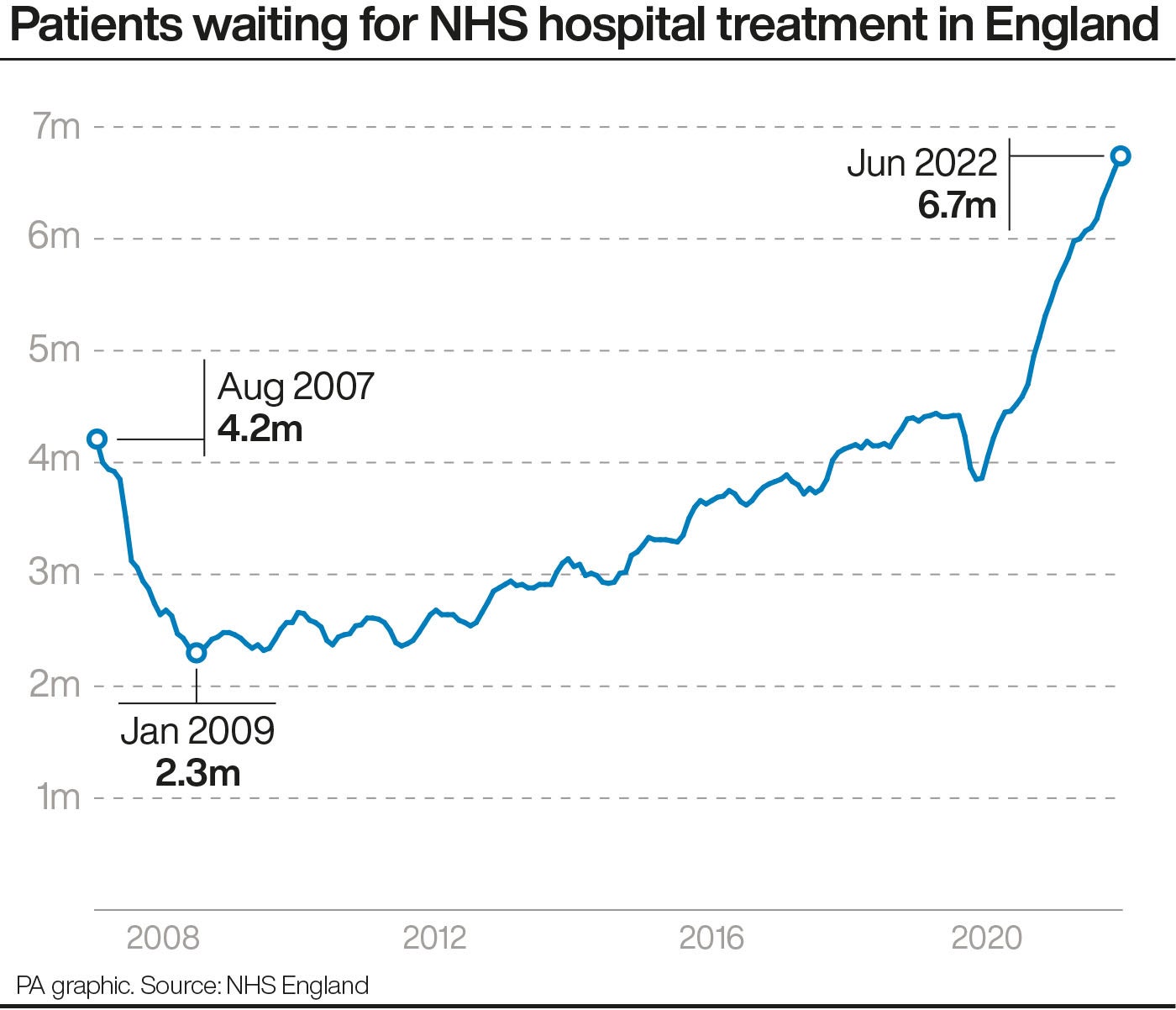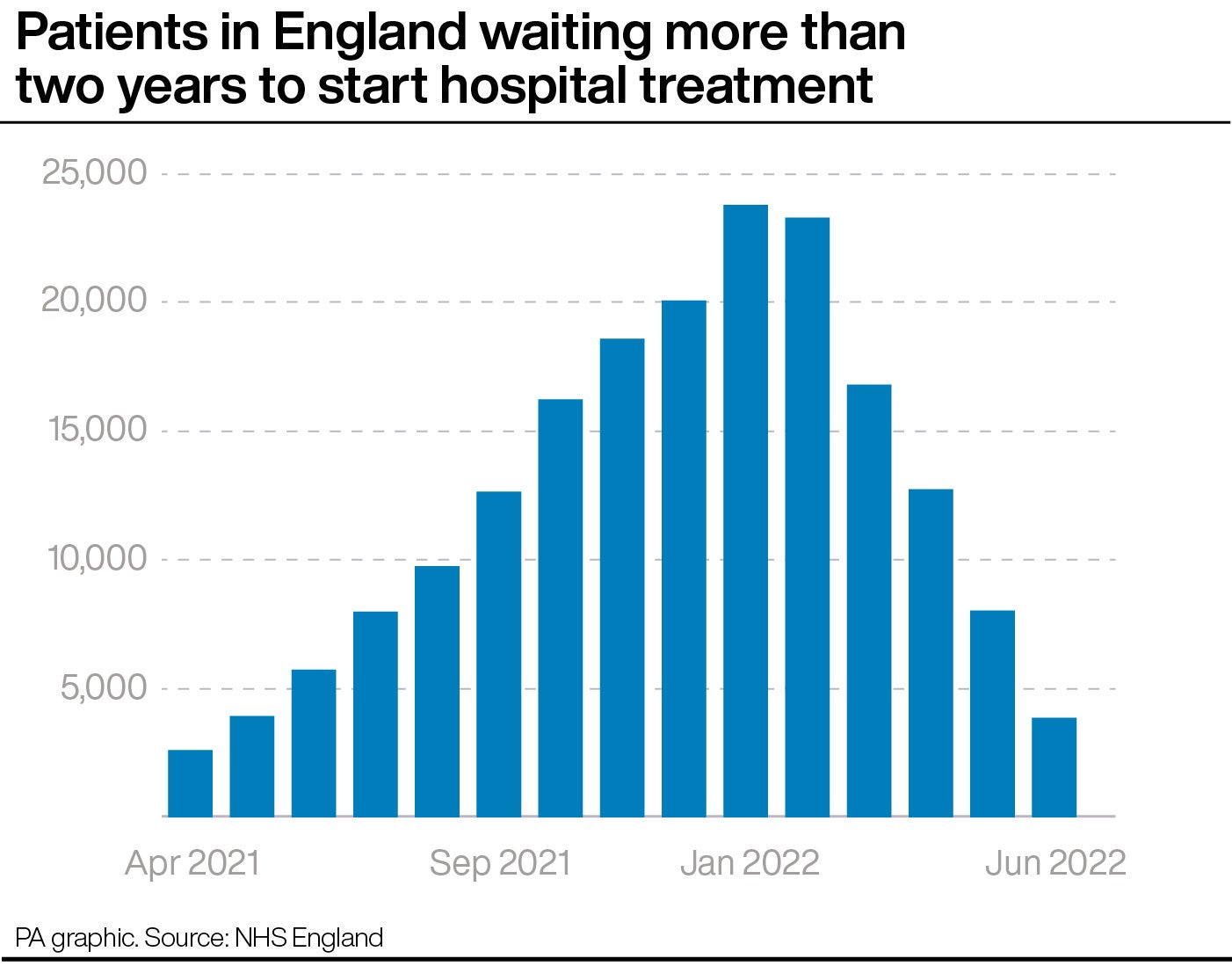
Here are the key figures from the latest data on the performance of the NHS in England:
– Overall waiting list
The number of people waiting to start routine hospital treatment has risen to a new high.
A total of 6.7 million people were waiting to start treatment at the end of June 2022, according to NHS England figures.
This is up from 6.6 million in May and is the highest number since records began in August 2007.

– Waits of more than two years
There were 3,861 people waiting more than two years to start treatment at the end of June.
This is down from a peak of 23,281 at the end of February and is now only slightly above the number of people who were waiting longer than two years in April 2021 (2,608).
The Government and NHS England set the ambition to eliminate all waits of more than two years, except when it is the patient’s choice, by July this year.
Provisional figures published by NHS England earlier this week suggested the number of people waiting more than two years stood at 2,777 as of July 31.

– Waits of more than a year
The number of people having to wait longer than 52 weeks to start hospital treatment in England was 355,774 in June, up from 331,623 the previous month.
The Government and NHS England have set the ambition of eliminating all waits of more than a year by March 2025.
– Hospital admissions
The number of people admitted for routine treatment in hospitals in England in June was 265,878 – down 4% from a year earlier (275,835).
The equivalent figure for June 2019, a non-pandemic year, was 289,203.
– A&E waits
A record 29,317 people had to wait more than 12 hours in A&E departments in England in July from a decision to admit to actually being admitted.
The figure is up 33% from 22,034 in June and is the highest for any calendar month in records going back to August 2010.
A total of 136,221 people waited at least four hours from the decision to admit to admission in July, up from 130,109 the previous month but slightly below the record 136,298 in March.
Meanwhile, 71.0% of patients in England were seen within four hours at A&Es last month, down from 72.1% in June and the lowest figure on record.
The operational standard states that at least 95% of patients attending A&E should be admitted, transferred or discharged within four hours, but this has not been met nationally since 2015.
– Ambulance response times
The average response time last month for ambulances in England dealing with the most urgent incidents, defined as calls from people with life-threatening illnesses or injuries, was nine minutes and 35 seconds, NHS England figures show.
This is up from nine minutes and six seconds in June, and is the joint longest average response time for this category of incidents since current records began in 2017.
The target standard response time for urgent incidents is seven minutes.
Ambulances took an average of 59 minutes and seven seconds last month to respond to emergency calls such as burns, epilepsy and strokes.
This is up from 51 minutes and 38 seconds in June, and is well above the target of 18 minutes.
It is just short of the longest response time on record for this category of incidents, which is one hour, one minute and five seconds, set in March this year.
Response times for urgent calls, such as late stages of labour, non-severe burns and diabetes, averaged three hours, 17 minutes and six seconds.
This is up from two hours, 53 minutes and 54 seconds in June, and is also just below the record for this category of three hours, 28 minutes and 12 seconds, which was set in March.
– Cancer referrals
Some 229,093 urgent cancer referrals were made by GPs in England in June.
This is down from 242,691 referrals in May, and also down slightly from 230,110 in June 2021, though still above the 194,047 reported in non-pandemic month of June 2019.
The proportion of patients in England seeing a specialist within two weeks in June was 78%, down from 83% in May, while 70% of patients urgently referred for suspected cancer were diagnosed or had cancer ruled out within 28 days, down slightly from 71% the previous month.
The elective recovery plan sets a goal of 75% of patients who have been urgently referred by their GP for suspected cancer to be diagnosed or have cancer ruled out within 28 days by March 2024.
– Diagnostic tests
More than 400,000 people in England had been waiting longer than six weeks for a key diagnostic test in June.
Some 430,037 patients, 27.5% of the total, were waiting longer than six weeks for one of 15 standard tests, including an MRI scan, non-obstetric ultrasound or gastroscopy.
The equivalent number in June 2021 was 306,117 (22.4% of the total).
The NHS elective recovery plan sets the ambition that 95% of patients needing a diagnostic test receive it within six weeks by March 2025.







